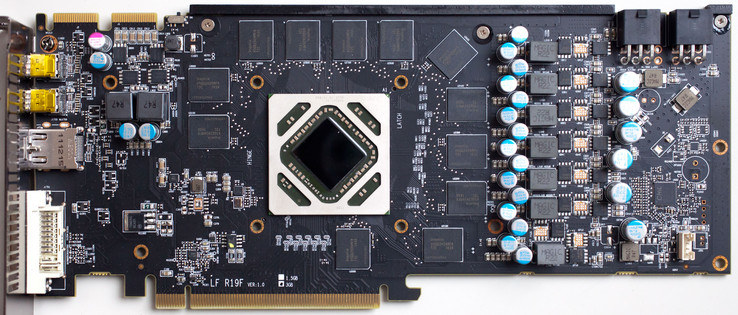FAQ: Coil Whine
What is it?
“Coil whine” is probably a term you have heard of before. As the name suggests, coil whine refers to the audible noise that is produced when an electrical current runs through — you guessed it — electromagnetic coils.While the noise can be drowned out among the whir of high-speed fans or muffled by an insulating case, this high-pitched “whine” can be particularly annoying for many users and is especially noticeable in notebooks. It can be even more distracting in fanless devices like some ultrabooks that you would expect to otherwise be totally silent.
Why does it happen?
The culprits behind this irritating noise, the electromagnetic coils, are found in all manners of electrical devices and components, and typically serve as inductors or transformers. As these devices have an electric current passed through them, they begin to resonate; at the right frequencies, these vibrations become audible noise, manifesting as a distinct whining hum.
In general, the more power that flows through the coils, the more pronounced the whine will become — a problem for many of today’s high-powered devices. Additionally, these vibrations and resulting noise tend to intensify with the age of the device, as users with older laptops might be all too familiar with.
How can it be prevented?
Although the phenomenon can worsen over time, the build-quality of a device can impact the amount of coil whine the user will experience — even with brand-new devices. On the side of the manufacturer, coil whine can be reduced by using specially designed noise-reducing coils or through a process called damping, which inhibits the degree to which the coils can oscillate.
Since the problem is the result of a physical process that occurs during the normal use of the device, there are unfortunately few ways of preventing coil whine outright. If the coil whine is coming from parts in a desktop setup, the best solution can often be to put them in a noise-isolating case. Alternatively, while plugging in a pair of headphones may not seem like a solution to the problem, this could be the simplest option for many users.
If the coil whine is substantial, it may warrant an RMA from the manufacturer. For example, in our testing of the Dell Latitude 7480, we found highly audible coil whine, spiking as high as 4000Hz. While the manufacturer may not grant a return or replacement simply based on coil whine, it should be considered as an option. Before requesting an RMA, make sure to narrow down the specific part that is producing the noise. A video guide[1] on Youtube shows desktop users how to isolate which part in your system is causing the coil whine. As described in the video, the most common producers of coil whine are the graphics card, the power supply, and the area around the CPU socket on the motherboard. In some cases, users have reported[2] that replacing the power supply can help reduce coil whine in other parts, as the variable power flowing through the coils is what causes the oscillation in the first place.
Alternative “fixes”
Although coil whine is a physical phenomenon, there are a few situations where software tweaks might solve some of the underlying issues when it occurs in your graphics card. As detailed[3] by popular tech Youtuber JayzTwoCents, applying some sort of FPS limiter, such as Nvidia GSync or Radeon Freesync, could potentially reduce the load on your graphics card—thus preventing the coils from excessively vibrating. The results in the video speak for themselves, and the process itself is as simple as ticking a box in the game’s display settings.
If, after attempting the options listed above, you are still met with unbearable coil whine, there may be another way of addressing it for the more technically inclined user. As suggested in a post[4] on the Overclock.net forums by user Phaedrus2129, it is conceivable that by overclocking or underclocking the device, one could alter the amount of power drawn by the device. In turn, this would effectively change the frequency at which the coils vibrate — potentially to the point where they are no longer audible.
A side note on frequencies
As mentioned above, coil whine occurs when the vibration of the coil reaches a specific frequency at which point it becomes audible. To narrow down this threshold, it is beneficial to examine a practical example. Many users of the Dell XPS 13 with either Sky Lake or Kaby Lake processors complained of particularly irritating levels of coil whine coming from the device.
In a post[5] on the Dell community forum, user hvbakel discovered that the amount of noise produced by the device seemed to be tied to the frequency at which the CPU was running. Notably, the coil whine was at its loudest when the CPU was running at very low (<1.2 GHz) or high (3.1 GHz) frequencies. By modifying the threshold at which intel_pstate driver would scale the frequency of each core, it was possible to have the CPU idle at a perfect medium of 2.5 GHz — thus, reportedly minimizing the coil whine.
Conclusion
While coil whine can be a bother, it is ultimately not a sign of poorly performing hardware. In the end, it is merely a result of a physical process that is tied to the operation of the device.
For users that are particularly concerned with the amount of noise coming from a device, it is always important to do the proper research beforehand. Reading user reviews can help set your expectations before purchasing that new laptop or upgrading to a beefier GPU.
For PC builders that want a completely silent experience, choosing the right case can make a world of difference. For most users, however, the quickest solution is just to drown out the noise with a simple pair of headphones — especially during more taxing activities like gaming or editing.
Source(s)
[1] https://www.youtube.com/watch?v=7DirFjf3OO4
[2] http://www.overclockers.com/forums/showthread.php/768240-Coil-Whine-Fixed-Solved-explained
[3] https://www.youtube.com/watch?v=jtXAuIJchps
[4] http://www.overclock.net/t/1094728/possible-fix-for-coil-whine
[5] en.community.dell.com/techcenter/os-applications/f/4613/t/19992655




